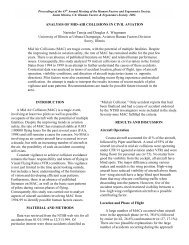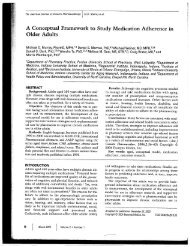Usability Questionnaire Results - Institute of Aviation - University of ...
Usability Questionnaire Results - Institute of Aviation - University of ...
Usability Questionnaire Results - Institute of Aviation - University of ...
You also want an ePaper? Increase the reach of your titles
YUMPU automatically turns print PDFs into web optimized ePapers that Google loves.
likely to have emergent features than separated displays. Emergent features allow for enhancedperformance because they have the ability to exchange perceptual cues for cognitive processing(Sanderson, Flach, Buttigieg, & Casey, 1989; Buttigieg & Sanderson, 1991; Bennett & Flach,1992; Vicente & Rasmussen, 1992). Instead <strong>of</strong> having to integrate information mentally aboutvarious sources <strong>of</strong> information, the emergent feature in essence does the cognitive processingperceptually and therefore more automatically. It is no longer necessary to perform morecomplex mental operations after examining multiple information sources. Instead, theperception <strong>of</strong> an emergent feature is all that needed since it represents the conclusion <strong>of</strong> all thecomplex mental operations that would have been performed.A classic example <strong>of</strong> an emergent feature can be seen with bar graphs. If three bar graphsare placed next to each other and have the same height when a “normal” state is occurring, animaginary line can be made across the top <strong>of</strong> the bar graphs. If some type <strong>of</strong> system changeoccurs and one bar graph’s height increases, the imaginary line connecting the tops <strong>of</strong> the bargraphs is no longer straight (Sanderson et al., 1989). This can be considered an emergent featuresince a person monitoring the graphs would be looking for any change in the imaginary line todetect problems.One example <strong>of</strong> an object displays depicts how emergent features can be made torepresent certain states <strong>of</strong> a system. Woods, Wise, and Hanes (1981) studied a display for anuclear power reactor that represented eight important parameters whose measures wereindicated by the length <strong>of</strong> spokes extending from the center <strong>of</strong> the display. The ends <strong>of</strong> eachspoke were connected to the next closest, thereby forming a polygon. This display providedemergent features in the shape <strong>of</strong> the polygon. In fact, specific system states and problems couldbe determined just by looking at the shape <strong>of</strong> the polygon. This supports both the detection <strong>of</strong>faults and especially diagnosing problems. Certain shapes <strong>of</strong> the polygon could be indicative <strong>of</strong>specific underlying problems. This understanding could be made through perception <strong>of</strong> theshape instead <strong>of</strong> through cognitive reasoning.Emergent features provide an additional useful source <strong>of</strong> information that is able to “popout” at the user. This is commonly called the salience <strong>of</strong> an emergent feature. The ability tohave such high salience accounts for part <strong>of</strong> the benefits in performance attributed to emergentfeatures that substitute perceptual processing for cognitive processing (Wickens & Carswell,1995). This can be quite beneficial when a task or process can be creatively mapped to a displayand utilizes an emergent feature.2.2.2.3 Configural DisplaysConfigural displays are a display format that involves the mapping <strong>of</strong> several individualvariables into a single geometrical that changes shape dynamically as a function <strong>of</strong> changes inthe individual variables (Bennett, Payne, Calcaterra, & Nittoli, 2000). Configural displays aredesigned to represent high-level constraints <strong>of</strong> a system through the relationships that existamong the low-level data that define the constraint (Bennett, Toms, & Woods, 1993).Configural displays are similar to object displays, but a key difference between the twodisplay formats is that configural displays are spatially laid out so that they will always producean emergent feature whereas object displays may or may not have emergent features.11















